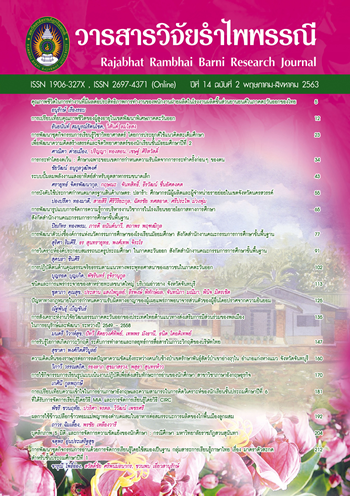The Development of Science Learning Activity Package by Applying The STEM Education Concept to Develop the Creativity and Scientific Mind for Grade Eight Students.
Main Article Content
Abstract
The research purposes were: (1) to develop science learning activity package by applying the STEM education concept to develop the creativity and scientific mind for grade eight students
(2) to study the creativity, scientific mind, and science achievement of the grade eight students after using the science learning activity. These results were researched and developed with 4 steps: (1) studying the basic information, (2) developing the science learning activity package, (3) testing the science learning activity package, and (4) assessing and adjusting science learning activity package. The samples were two groups of grade eight students at Piboonbumpen Demonstration School of Burapha University. The samples were divided into two groups by using cluster random sampling: the experimental group and the control group. The research instrument were science learning activity package, lesson plans, creativity test, scientific mind assessment, and science learning achievement test.
The data were analyzed by percentage, standard deviation, Dependent t – test and Independent t – test. The results of the research were:
- The researcher was able to develop science learning activity package by applying the STEM education concept to develop the creativity and scientific mind for grade eight students. The assessment of these activities from the experts were very good.
- The data analysis could be concluded that:
2.1. the mean of creativity of the example group after using science learning activity package was higher than before with the statistic significance at .05 (t = 7.421) ;
2.2. the mean of creativity of the experiment group after using science learning activity package was higher than the mean of creativity of the example group by teaching with a normal approach with the statistical significance at .05 (t = 2.840);
2.3. the mean of scientific mind of the example group after using science learning activity package was higher than before with the statistic significant at .05 (t = 8.800);
2.4. there was no significant difference (p<.05) in mean of scientific mind between the experimental group and control group. (t = .580);
2.5. the mean of science achievement of the example group after using science learning activity package was higher than before with the statistical significance at .05 (t = 15.696);
2.6. the mean of science achievement of the experiment group after using science learning activity package was higher than the mean of science achievement of the example group by teaching with a normal approach with the statistical significance at .05 (t = 2.420).
Article Details
References
2. กระทรวงพลังงาน. (2558). รายงานการอนุรักษ์พลังงานของประเทศไทย. กระทรวงพลังงาน. (มกราคม – ธันวาคม). กรมพัฒนาพลังงานทดแทนและอนุรักษ์พลังงาน, หน้า 1.
3. กระทรวงศึกษาธิการ. (2551). หลักสูตรแกนกลางการศึกษาขั้นพื้นฐาน พุทธศักราช 2551. กรุงเทพฯ: สำนักวิชาการและมาตรฐานการศึกษา สำนักงานคณะกรรมการการศึกษาขั้นพื้นฐาน.
4. กวิน เชื่อมกลาง. (2559). นาวาฝ่าวิกฤต ตัวอย่างการจัดกิจกรรมการเรียนรู้แบบบูรณาการตามแนวทางสะเต็มศึกษา สำหรับนักเรียนชั้นมัธยมศึกษาปีที 3. นิตยสารสถาบันส่งเสริมการสอนวิทยาศาสตร์และเทคโนโลยี. (มกราคม – กุมภาพันธ์).
5. ดารารัตน์ ชัยพิลา. (2558). ผลกิจกรรมการเรียนรู้แบบโครงงานตามแนวคิด STEM Education ที่มีต่อความสามารถ ในการแก้ปัญหาอย่างสร้างสรรค์ทางวิทยาศาสตร์ เรื่อง ปฏิกิริยาเคมี ของนักเรียนชั้นมัธยมศึกษาปีที่ 2. ปริญญาการศึกษามหาบัณฑิต สาขาวิชาวิทยาศาสตร์ศึกษา มหาวิทยาลัยนเรศวร.
6. ธงไชย ต้นทัพไทย. (2548). การศึกษาผลสัมฤทธิ์ทางการเรียนรู้วิทยาศาสตร์ และค่านิยมการบริโภคอาหารของนักเรียนชั้นมัธยมศึกษาปีที่ 2 ที่สอนโดยใช้ชุดกิจกรรมพัฒนาศักยภาพการเรียนรู้ทางวิทยาศาสตร์. วิทยานิพนธ์การศึกษามหาบัณฑิต บัณฑิตวิทยาลัย มหาวิทยาลัยศรีนครินทรวิโรฒ.
7. บัวพิศ ภักดีวุฒิ. (2558). การพัฒนาความคิดสร้างสรรค์ของนักเรียนระดับชั้นมัธยมศึกษาปีที่ 1 โรงเรียนวังหลวงพิทยาสรรพ์ จังหวัดหนองคาย โดยใช้ชุดฝึกทักษะพื้นฐานและชุดกิจกรรมการเรียนรู้ ตามวงจรการปฏิบัติการคิดสร้างสรรค์ของ Plsek. ปริญญาการศึกษามหาบัณฑิต มหาวิทยาลัยมหาสารคาม.
8. นัสรินทร์ บือซา. (2557). ผลการจัดการเรียนรู้ตามแนวคิดสะเต็มศึกษา (STEM Education) ที่มีต่อผลสัมฤทธิ์ทางการเรียนชีววิทยา ความสามารถในการแก้ปัญหาและความพึงพอใจต่อการจัดการเรียนรู้ของนักเรียนชั้นมัธยมศึกษาปีที่ 5. ปริญญาศึกษาศาสตร์มหาบัณฑิต สาขาวิชาการสอนวิทยาศาสตร์และคณิตศาสตร์ บัณฑิตวิทยาลัย มหาวิทยาลัยสงขลานครินทร์.
9. พิศิษฐ ตัณฑวณิช. (2558). แนวคิดการจำแนกพฤติกรรมการเรียนรู้ตามวัตถุประสงค์การจัดการศึกษาด้านพุทธพิสัยตามแนวคิดของบลูมและคณะฉบับปรับปรุง. วารสารมหาวิทยาลัยราชภัฏลำปาง. (ตุลาคม 2557–มีนาคม 2558).
10. ไพศาล วรคำ. (2552). การวิจัยทางการศึกษา. มหาสารคาม : มหาวิทยาลัยราชภัฎมหาสารคาม.
11. สมเกียรติ พรพิสุทธิมาศ. (2556). การจัดการเรียนรู้วิทยาศาสตร์ในศตวรรษที่ 21. ภาควิชาชีววิทยาและหน่วยวิจัยวิทยาศาสตร์เทคโนโลยีและสิ่งแวดล้อมเพื่อการเรียนรู้คณะวิทยาศาสตร์ มหาวิทยาลัยศรีนครินทรวิโรฒ เขตวัฒนา กรุงเทพฯ 10110. (2556, เมษายน).
12. สุพรรณี ชาญประเสริฐ. (2557). สะเต็มศึกษากับการจัดการเรียนรู้ในศตวรรษที่ 21. นิตยสารสถาบันส่งเสริมการสอนวิทยาศาสตร์และเทคโนโลยี. (2557, มกราคม – กุมภาพันธ์).
13. สุพรรณี ชาญประเสริฐ. (2556). การจัดการเรียนรู้วิทยาศาสตร์และทักษะที่จำเป็นในศตวรรษที่ 21. นิตยสารสถาบันส่งเสริมการสอนวิทยาศาสตร์และเทคโนโลยี. (2556, พฤศจิกายน – ธันวาคม).
14. Miles, Elzabeth. (1999). Tune your brain. New York : The Berkley Publishing Group. Nickerson.
15. Torrance E.P. (1965). Rewarding creative behavior : experiments in classroom creativity. Englewood cliffs, N.J. : Prentice Hall inc.

